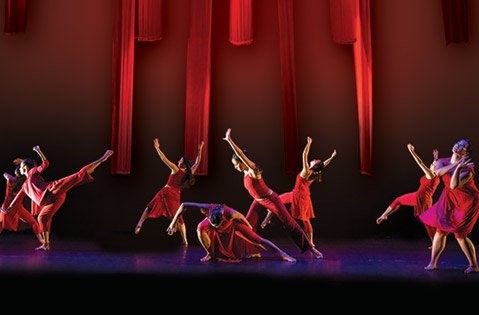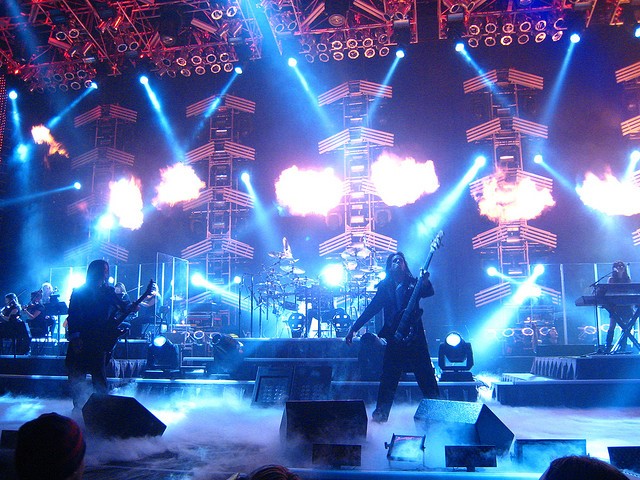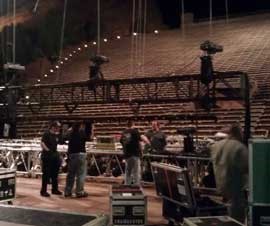Safety in the theatre extends to crews, casts, and audience members as well as its environment. This includes performance and rehearsal spaces, shops and other work spaces. It requires awareness, common sense, and perseverance to eliminate hazards and guard against carelessness. On the UCSB campus, performing arts activities include academic programs in theater, dance, music, and drama. Additionally, campus facilities are used by “roadhouse” companies that coordinate and manage professional traveling shows including plays, concerts, lectures and other events.

The goal of our Theater & Performance Safety Program is to ensure that a safe, healthy environment shall be maintained at all times within all campus Theatre & Performing Arts departments and programs. This includes the control and minimization of all known and potential hazards associated within creative, artistic, and performance development. Many processes, techniques, materials, and practices used in the theatre & performing arts contain potential risks to individuals. These risks can be minimized and controlled through proper training, equipment, and use of appropriate precautions, restrictions, and established safe-work practices.
The University of California, Office of the President funded the development of a system-wide Performing Arts Safety Manual. The purpose of the University of California Performing Arts Safety Manual is to provide faculty, staff, and students who work or participate in the performing arts with a general overview of potential hazards and related safe work procedures. This manual is designed to follow a theater production from the planning stages to strike as outlined in its table of contents. The Performing Arts New Employee Checklist and the Codes of Safe Practice provide additional information on safe work procedures. All are excellent resources to assist you in:


- Recognizing and understanding the hazards associated with various performing arts operations and activities,
- Knowing when to apply various types of health and safety controls such as engineered devices (ventilation, machine guards, etc.), administrative practices (safety training, warning signs, etc.), or personal protective equipment (PPE) (respirators, safety glasses, hearing protection),
- Planning for and responding to emergencies such as fires, earthquakes, or chemical spills.
Roles and Responsibilities
Deans and Department Chairpersons are responsible for ensuring an effective Injury & Illness Prevention Program (IIPP) is implemented in all areas under their scope of responsibility. For performing arts activities, this would include all facilities where employees and students work or are involved with production activities including the scene shop, costume shop, prop shop, stage area, front of house, music recital hall, catwalks, etc. Upper management must assign and authorize designated individuals to establish and support the key processes and procedures of the IIPP.

Supervisors are faculty and staff that oversee and direct others. Within University programs, this might include Directors, Producers, Stage Managers, House Managers, Technical Directors, or Scene Shop Managers. Supervisors play a critical role in the implementation of the IIPP and must be empowered and authorized to:
- develop safe work practices and procedures,
- enforce health and safety rules,
- stop work activities that pose imminent danger,
- ensure routine documented safety inspections occur,
- provide or coordinate safety training,
- make available and ensure proper use of PPE,
- report and investigate injuries and incidents, and
- maintain health and safety documentation associated with the IIPP.
Employees and students, including student employees, volunteers, and students engaged in academic activities, are accountable for understanding health and safety rules and for following safe work practices. Employees and students must:
- obtain appropriate training for designated activities,
- use PPE as required and directed,
- report unsafe conditions, malfunctioning equipment, and other safety concerns,
- report all work-related injuries and incidents, and
- understand what to do in the event of an emergency.
EH&S/Industrial Safety provides health and safety consultation to all levels of individuals within the UCSB campus Theater & Performance departments/programs. EH&S safety professionals may:
- assist with safety program implementation,
- develop and provide safety training,
- perform safety inspections,
- conduct job or task hazard evaluations,
- conduct incident investigations, and
- monitor compliance.
For further information and training resources, please contact the EH&S Industrial Safety Program at ehs-industrialsafety@ucsb.edu.